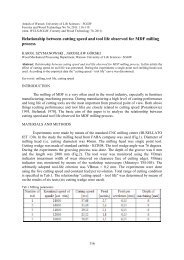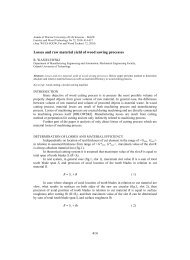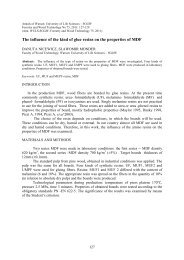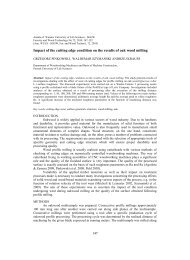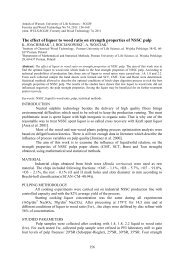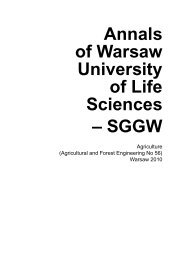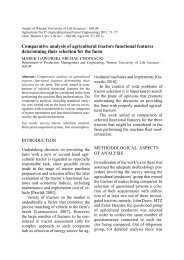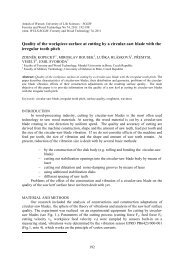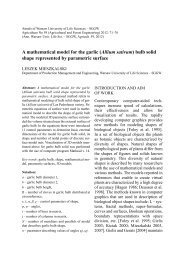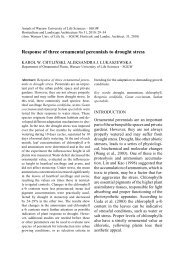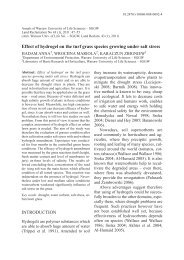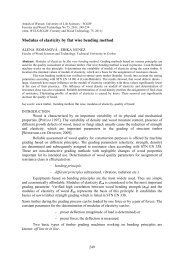46 M. Sojak, Sz. GłowackiMODELLING OF VEGETABLECHIPS DRYINGProcess <strong>of</strong> convectional drying <strong>of</strong>very moist solid bodies occurs in twosignificantly different drying periods. Inthe first period the process is influencedby conditions <strong>of</strong> water particle transportfrom the surface <strong>of</strong> body subjected todrying through the boundary layer <strong>of</strong>gas; in conventional second period <strong>of</strong>drying, the process is influenced bythe conditions <strong>of</strong> internal diffusion <strong>of</strong>these particles to body surface. In fact,transition from the first to second periodproceeds constantly. This period is calleda transitory period and it is not welllearned theoretically, while only parts<strong>of</strong> its mathematical models are known(Jaros and Pabis 2006). The kineticmodel considering the effect <strong>of</strong> dryingshrinkage was checked in this work inthe range (u 0 , u cr ) (Pabis 1999):u() τ⎡N⎛ b= ub Nu k ⎞⎢1⎤⎜ τ⎟− ⎥0 1− 1− ⎢1−⎝ 0 ⎠bb0 1−⎥⎣⎦(1)This model was proved with maximallocal error not bigger than 11% in therange <strong>of</strong> water content from 7.5 to about2 kg·kg –1 and for coefficient b = 0.056,determined in drying process <strong>of</strong> anotherpumpkin variety (Sojak 2000).The exponent N value in equation(1) can be determined eg.: by trial-anderror method or it can be calculated(Pabis and Jaros 2002) basing on results<strong>of</strong> measurements on changes in shapeparameters (Sojak and Jaros 1999).The second model to be verified forthe range (u 0 , u cr ) is:u() τ = ue + ( ucr −ue) exp(− Kτ)(2)Equation (2) was proved withmaximal local error not bigger than 15%in the range <strong>of</strong> water content from about2 to about 0.02–0.16 kg·kg –1 .In respect to maintaining <strong>of</strong> processcontinuity in point u = u cr , drying speedsin the first and second periods must beequal, thus, (du/dτ ) I = (du/dτ ) II (Sojak2000).Then, coefficient <strong>of</strong> drying speed canbe calculated (Jaros and Pabis, 2006)from equation:K =k0ucr− ue( )⎛ Nb−−−1⎜Nu k ⎞1 1 cr ⎟⎝ 0 0 τ (3)⎠VERIFICATION OF MODELSFOR THE FIRST AND SECONDDRYING PERIODSFigure 1 presents results <strong>of</strong> threerepetitions <strong>of</strong> measurements on changesin water content in pumpkin slices <strong>of</strong>thickness 5 and 10 mm at drying mediumtemperature 80°C and drying mediumspeed 1.2 m·s –1 . Changes in water contentwere described with the mean functionsin the form <strong>of</strong> cubic polynomials selectedso, that relative error was lower then 1%;their graphical interpretation is presentedin Figure 1.Coefficient N in model (1) wasdetermined by subsequent approximationsso, that model relative error <strong>of</strong> watercontent was possibly lowest according tomethod given by Jaros and Pabis (2006).The value <strong>of</strong> k 0 coefficient <strong>of</strong> initialdrying speed was determined by linearregression method, basing on watercontent initial measurements.
Investigations on drying <strong>of</strong> new pumpkin varieties 4787u [kg . kg -1 ]65432J, 5 mmJ, 10 mmZ, 5 mmZ, 10 mmB, 5 mmB, 10 mm100 100 200 300 400τ [min]FIGURE 1. Graphical representation <strong>of</strong> formulae approximating results <strong>of</strong> water content measurements(u) in time (τ) for pumpkin chips o varieties Justyna (J), Amazonka (Z) and Ambar (B) <strong>of</strong> slice thickness5 and 10 mm, dried at temperature 80°C and drying medium speed 1.2 m·s –1The course <strong>of</strong> drying speed wasdetermined basing on measurements onwater content. Figure 2a presents dryingspeed <strong>of</strong> pumpkin chips <strong>of</strong> Justynkavariety in slices <strong>of</strong> thickness 10 mmdepending on drying duration, while inFigure 2b the drying speed is dependenton instant water content calculated frommeasurements.Analysis <strong>of</strong> drying speed <strong>of</strong>investigated samples points out(especially on diagrams <strong>of</strong> b type)that at water content <strong>of</strong> 2 kg·kg –1 themechanism <strong>of</strong> mass exchange is changedand also the drying speed decreasesrapidly. Therefore, it was assumed thatthe critical content is equal to or is closeto 2 kg·kg –1 .a) b)k, K [min -1 ]0,070,060,050,040,030,020,010,000 100 200 300 400τ [min]k, K [min -1 ]0,070,060,050,040,030,020,010,000 1 2 3 4 5 6 7 8 9u [ kg . kg -1 ]FIGURE 2. Diagrams <strong>of</strong> drying speed in I and II drying periods (thin line, k and thick line, K, respectively)for pumpkin chips <strong>of</strong> Justynka variety <strong>of</strong> thickness 10 mm, dried at temperature 80°C and dryingmedium speed 1.2 m·s –1
- Page 1: Annalsof WarsawUniversityof LifeSci
- Page 7 and 8: Inveatigations on soil conservation
- Page 9 and 10: Inveatigations on soil conservation
- Page 11 and 12: Inveatigations on soil conservation
- Page 13 and 14: Annals of Warsaw University of Life
- Page 15 and 16: Precision and energy parameters of
- Page 17 and 18: Precision and energy parameters of
- Page 19 and 20: Precision and energy parameters of
- Page 21: Precision and energy parameters of
- Page 24 and 25: 24 A. Lisowski et al.62.8, 59.4 and
- Page 26 and 27: 26 A. Lisowski et al.TABLE 2. Param
- Page 28 and 29: 28 A. Lisowski et al.in three and t
- Page 30 and 31: 30 A. Lisowski et al.według normy
- Page 33: Economic effi ciency of growing and
- Page 36 and 37: 36 J. Jánský, I. ŽivělováTABLE
- Page 39 and 40: Annals of Warsaw University of Life
- Page 41 and 42: Effect of storage conditions on bio
- Page 43 and 44: Effect of storage conditions on bio
- Page 45: Annals of Warsaw University of Life
- Page 49 and 50: Investigations on drying of new pum
- Page 51 and 52: Annals of Warsaw University of Life
- Page 53 and 54: Analysis of optimal values of air s
- Page 55 and 56: Analysis of optimal values of air s
- Page 57: Analysis of optimal values of air s
- Page 60 and 61: 60 M. Klimkiewicz- units and parts
- Page 62 and 63: 62 M. Klimkiewiczwhere: S(x l,…,
- Page 64 and 65: 64 M. KlimkiewiczTABLE 5. Matrix of
- Page 67 and 68: Annals of Warsaw University of Life
- Page 69 and 70: Properties and structure of spheroi
- Page 71: Properties and structure of spheroi
- Page 74 and 75: 74 G. Elmasry, N. Wang, C. Vigneaul
- Page 76 and 77: 76 G. Elmasry, N. Wang, C. Vigneaul
- Page 78 and 79: 78 G. Elmasry, N. Wang, C. Vigneaul
- Page 81 and 82: Annals of Warsaw University of Life
- Page 83 and 84: Hyperspectral imaging for chilling
- Page 85 and 86: Hyperspectral imaging for chilling
- Page 87 and 88: Hyperspectral imaging for chilling
- Page 89 and 90: Annals of Warsaw University of Life
- Page 91 and 92: Experimental verifying of mathemati
- Page 93: Experimental verifying of mathemati
- Page 96 and 97:
96 J. Kára, Z. Pastorek, R. Adamov
- Page 98 and 99:
98 J. Kára, Z. Pastorek, R. Adamov
- Page 100 and 101:
100 J. Kára, Z. Pastorek, R. Adamo
- Page 103 and 104:
Annals of Warsaw University of Life
- Page 105 and 106:
New fermentation source in the tech
- Page 107 and 108:
Annals of Warsaw University of Life
- Page 109 and 110:
Agricultural business extension aid
- Page 111 and 112:
Agricultural business extension aid
- Page 113 and 114:
Agricultural business extension aid



